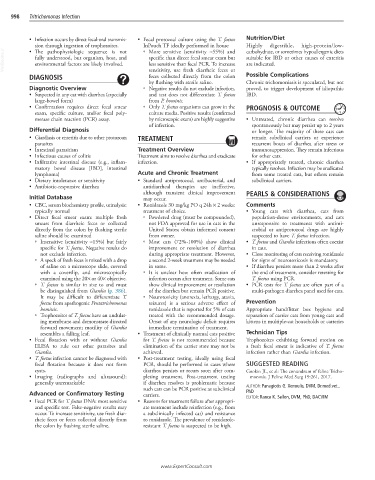Page 1994 - Cote clinical veterinary advisor dogs and cats 4th
P. 1994
998 Tritrichomonas Infection
• Infection occurs by direct fecal-oral transmis- • Fecal protozoal culture using the T. foetus Nutrition/Diet
sion through ingestion of trophozoites. InPouch TF ideally performed in house Highly digestible, high-protein/low-
VetBooks.ir fully understood, but organism, host, and specific than direct fecal smear exam but suitable for IBD or other causes of enteritis
carbohydrate, or sometimes hypoallergenic diets
○ More sensitive (sensitivity ≈55%) and
• The pathophysiologic sequence is not
are indicated.
less sensitive than fecal PCR. To increase
environmental factors are likely involved.
feces collected directly from the colon
DIAGNOSIS sensitivity, use fresh diarrheic feces or Possible Complications
by flushing with sterile saline. Chronic trichomoniasis is speculated, but not
Diagnostic Overview ○ Negative results do not exclude infection, proved, to trigger development of idiopathic
• Suspected in any cat with diarrhea (especially and test does not differentiate T. foetus IBD.
large-bowel form) from P. hominis.
• Confirmation requires direct fecal smear ○ Only T. foetus organisms can grow in the PROGNOSIS & OUTCOME
exam, specific culture, and/or fecal poly- culture media. Positive results (confirmed
merase chain reaction (PCR) assay. by microscopic exam) are highly suggestive • Untreated, chronic diarrhea can resolve
of infection. spontaneously but may persist up to 2 years
Differential Diagnosis or longer. The majority of these cats can
• Giardiasis or enteritis due to other protozoan TREATMENT remain subclinical carriers or experience
parasites recurrent bouts of diarrhea after stress or
• Intestinal parasitism Treatment Overview immunosuppression. They remain infectious
• Infectious causes of colitis Treatment aims to resolve diarrhea and eradicate for other cats.
• Infiltrative intestinal disease (e.g., inflam- infection. • If appropriately treated, chronic diarrhea
matory bowel disease [IBD], intestinal typically resolves. Infection may be eradicated
lymphoma) Acute and Chronic Treatment from some treated cats, but others remain
• Dietary intolerance or sensitivity • Standard antiprotozoal, antibacterial, and subclinical carriers.
• Antibiotic-responsive diarrhea antidiarrheal therapies are ineffective,
although transient clinical improvement PEARLS & CONSIDERATIONS
Initial Database may occur.
• CBC, serum biochemistry profile, urinalysis: • Ronidazole 30 mg/kg PO q 24h × 2 weeks: Comments
typically normal treatment of choice. • Young cats with diarrhea, cats from
• Direct fecal smear exam: multiple fresh ○ Powdered drug (must be compounded), population-dense environments, and cats
smears from diarrheic feces or collected not FDA approved for use in cats in the unresponsive to treatments with antimi-
directly from the colon by flushing sterile United States; obtain informed consent crobial or antiprotozoal drugs are highly
saline should be examined from owner. suspected to have T. foetus infection.
○ Insensitive (sensitivity ≈15%) but fairly ○ Most cats (72%-100%) show clinical • T. foetus and Giardia infections often coexist
specific for T. foetus. Negative results do improvement or resolution of diarrhea in cats.
not exclude infection. during appropriate treatment. However, • Close monitoring of cats receiving ronidazole
○ A speck of fresh feces is mixed with a drop a second 2-week treatment may be needed for signs of neurotoxicosis is mandatory.
of saline on a microscope slide, covered in some. • If diarrhea persists more than 2 weeks after
with a coverslip, and microscopically ○ It is unclear how often eradication of the end of treatment, consider retesting for
examined using the 20× or 40× objective. infection occurs after treatment. Some cats T. foetus using PCR.
○ T. foetus is similar in size to and must show clinical improvement or resolution • PCR tests for T. foetus are often part of a
be distinguished from Giardia (p. 386). of the diarrhea but remain PCR positive. multi-pathogen diarrhea panel used for cats.
It may be difficult to differentiate T. ○ Neurotoxicity (anorexia, lethargy, ataxia,
foetus from apathogenic Pentatrichomonas seizures) is a serious adverse effect of Prevention
hominis. ronidazole that is reported for 5% of cats Appropriate hand/litter box hygiene and
○ Trophozoites of T. foetus have an undulat- treated with the recommended dosage. separation of carrier cats from young cats and
ing membrane and demonstrate directed Onset of any neurologic deficit requires kittens in multiple-cat households or catteries
forward movement; motility of Giardia immediate termination of treatment.
resembles a falling leaf. • Treatment of clinically normal cats positive Technician Tips
• Fecal flotation with or without Giardia for T. foetus is not recommended because Trophozoites exhibiting forward motion on
ELISA to rule out other parasites and elimination of the carrier state may not be a fresh fecal smear is indicative of T. foetus
Giardia. achieved. infection rather than Giardia infection.
• T. foetus infection cannot be diagnosed with • Post-treatment testing, ideally using fecal
fecal flotation because it does not form PCR, should be performed in cases where SUGGESTED READING
cysts. diarrhea persists or recurs soon after com- Gookin JL, et al: The conundrum of feline Tricho-
• Imaging (radiographs and ultrasound): pleting treatment. Post-treatment testing monosis. J Feline Med Surg 19:261, 2017.
generally unremarkable if diarrhea resolves is problematic because
such cats can be PCR positive as subclinical AUTHOR: Panagiotis G. Xenoulis, DVM, Dr.med.vet.,
Advanced or Confirmatory Testing carriers. PhD
• Fecal PCR for T. foetus DNA: most sensitive • Reasons for treatment failure after appropri- EDITOR: Rance K. Sellon, DVM, PhD, DACVIM
and specific test. False-negative results may ate treatment include reinfection (e.g., from
occur. To increase sensitivity, use fresh diar- a subclinically infected cat) and resistance
rheic feces or feces collected directly from to ronidazole. The prevalence of ronidazole-
the colon by flushing sterile saline. resistant T. foetus is suspected to be high.
www.ExpertConsult.com

